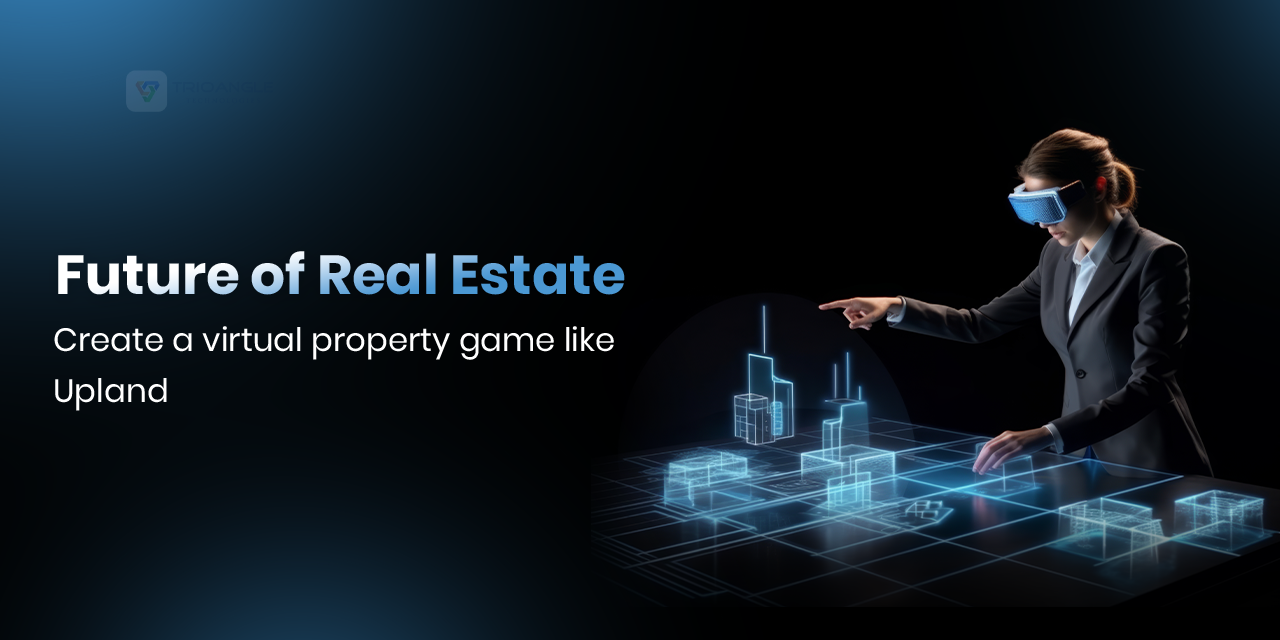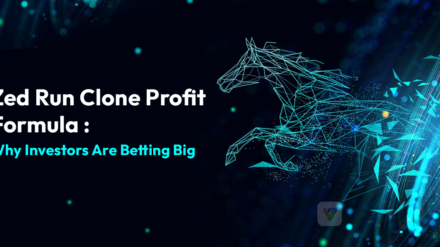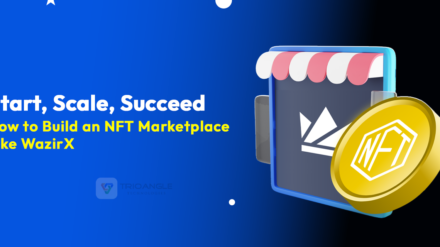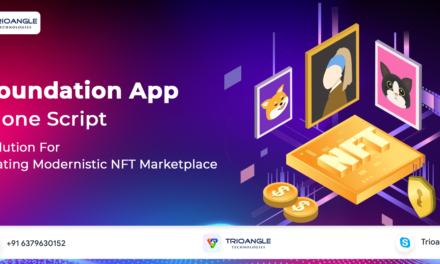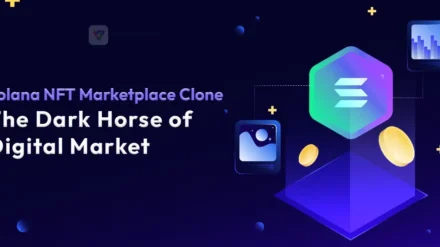Buying a piece of land in New York… but not with a deed. You buy it with crypto. You own it on a digital map. And yet, it’s tied to a real-world address. This isn’t fiction. It’s the power behind Upland… and today. Wish to create Virtual Property Game like Upland? A way opens for it.
If you’ve ever dreamed of owning a city block in the metaverse. Or building your own virtual real estate nft game, this blog is your roadmap.
From smart contracts to real-world mapping APIs… We’ll explore how a Virtual Real Estate NFT marketplace development can turn pixels into profitable property.
What is Upland?
Upland is a virtual real estate NFT game. Where players can buy, sell, and trade digital properties with real-world addresses. The EOS blockchain powers it, and its in-game currency is UPX. Every property is a tradable NFT, providing transparency and actual ownership.
Upland’s core idea is simple: tokenized ownership of land. But it’s more complex. It ties games to real-world locations. Giving players a unique combination of gameplay, economy, and blockchain utility. Players can build virtual businesses, flip houses, and generate passive revenue in this digital economy. Which goes beyond a simple game.
Its success demonstrates the effectiveness of an NFT marketplace clone script. Inspired entrepreneurs are now looking to develop games like Upland. Use Upland clone scripts to create a Virtual Property Game like Upland or virtual real estate nft game businesses. This combination of gaming and blockchain is changing the landscape of digital real estate ownership.
Is It Profitable to Create a Virtual Property Game like Upland?
Yes, if done right… Launching a Upland clone script can be profitable. It enables business owners to take advantage. In the increasing demand for virtual real estate nft game development. Upland clone script is a ready-to-use software that mimics Upland’s performance. Such as NFT land trading, UPX-like tokens, and real-world map integration.
It’s fast to deploy, easy to customize, and far more affordable than building from scratch. You can create a game like Upland in weeks instead of months. It’s perfect for NFT entrepreneurs, game developers, and metaverse startups. Who are all looking to start a virtual real estate nft game business. Or build a metaverse property platform.
The script supports blockchain tech, NFT standards, and real-time land minting. It also allows flexible monetization models—asset sales, property taxes, and upgrades. The best Upland clone software gives you full ownership and scalability.
With the right execution, it becomes a powerful tokenized land ownership platform. Ready for Web3’s future.
Curious how an Upland Clone Script can power your own virtual property empire? Let’s dive into the tech that makes it all possible.
NFT Minting and Ownership Mechanics to Create a Virtual Property Game like Upland
In an Upland clone script, every virtual land is a unique NFT. It uses blockchain to prove ownership. Here’s how it works.
#1 How Virtual Land Becomes an NFT
Geolocation data is used to map each land parcel to a physical address. An NFT is created using this data and metadata such as size, city, and ownership history. The tokenized land ownership platform assures that each plot is unique. And traceable on the blockchain.
#2 Lazy Minting vs Upfront Minting
NFT creation is delayed by lazy minting until a user purchases it. This results in cost savings. It is the best for scaling. In contrast, upfront minting generates all NFTs ahead. It’s useful for limited land releases and early buzz.
Smart real estate metaverse scripts often support both options. Giving control over gas fees, timing, and market flow.
#3 Land Uniqueness and Scarcity Logic
To create a game like Upland, you must ensure every virtual plot is non-duplicable. The upland-style game development logic relies on a scarcity model—based on real maps. Once a plot is sold, no other user can mint the same location. This creates value.
#4 Smart Contract Workflows
The NFT marketplace clone script powers workflows like:
- Buy: Transfers land NFT to the buyer.
- Sell: Lists the NFT with price, location, and metadata.
- Transfer: Allows peer-to-peer land gifting or trade.
- Burn: Deletes a land NFT, freeing up virtual space.
These flows are handled by smart contracts. transparent and immutable. That’s how an upland-like metaverse platform achieves secure ownership and player trust.
By using the best Upland clone software entrepreneurs can start a virtual real estate busines. with strong NFT mechanics and ready-to-scale logic.
Technical Architecture Overview of a Upland Clone Script
A powerful Upland clone script requires collaboration of several technologies. From frontend to blockchain, each has a distinct function. This is how it all goes together to Create a Virtual Property Game like Upland:
#1 Blockchain Integration
This is where your virtual land lives.
- EOS: Upland makes use of EOS. It is quick and users don’t have to pay for gas.
- Ethereum: Very popular and safe, but gas prices are expensive.
- Polygon: A faster and less expensive Ethereum version.
- Solana: quite fast and inexpensive. Excellent for games with a large user base.
The blockchain records ownership information. It provides transparency and security to land ownership.
#2 Smart Contracts
- Smart contracts are code-based rules that execute on their own.
- used to buy, sell, transfer, or mint virtual land NFTs.
- No intermediary is required. It’s all automated.
In your game, they handle real estate transactions fast and securely.
#3 NFT Standards (ERC-721, etc.)
These are rules for how NFTs behave on the blockchain.
- ERC-721: For unique land plots.
- Includes data like GPS, city, and owner name.
- Makes every land NFT different and easily tradeable.
#4 Real-World Map API (Google Maps, Mapbox)
- This allows your game to incorporate real-world locations.
- shows real land shapes, buildings, and streets.
- You turn real map locations into virtual properties.
- Makes your game feel realistic. Players buy land that exists in real life.
#5 Database Layer
- A location to store more data.
- keeps data such as land photos, previous sales, and user profiles.
- makes use of tools like PostgreSQL, Firebase, and MongoDB.
- Blockchains cannot store too much data. The rest is handled by databases.
#6 Backend (Node.js / Python / Go)
The brain that powers your game.
- Node.js: Quick and efficient at handling real-time updates.
- Python: Great for pricing, land logic, and analytics.
- Go: Very fast, used in large-scale apps.
Handles login, game rules, and connects frontend to blockchain.
#7 Frontend (React / Unity)
what users click and view.
- React: Excellent for land views, NFT lists, and dashboards.
- Unity: Creates 3D representations of your land and map.
Provides a quick and fun way for players to trade and explore land.
#8 Hosting & Deployment (AWS, IPFS, etc.)
where your game is hosted online.
- AWS: Cloud hosting for databases and backend operations.
- IPFS: Decentralized storage for images and NFTs.
- Docker: Helps with app deployment and updates.
Keep your game fast, secure, and always online.
Use this as your tech guide when choosing the best upland clone software. And go from idea to launch with confidence.
ERC Standards for Virtual Property Trading
In the realm of virtual real estate, users are able to purchase, sell, and exchange digital property. The ERC standards of Ethereum serve as a foundation. These standards aid in defining the creation, storing, and trading of digital properties on the blockchain.
If you’re planning to create a Virtual Property Game like Upland. Understanding these standards is a must.
#ERC-20 (Fungible Token Standard)
In-game currency (such as UPX in Upland) and utility tokens are used in virtual property trading. a fungible token standard in which the value of each token is the same.
Most virtual land platforms (like Upland) use an in-game currency. For example, UPX in Upland is a fungible token used to buy, sell, and trade land.
Use Case: If you’re planning a token economy for staking, fees, or governance. ERC-20 will be foundational.
#ERC-721 – The Non-Fungible Token (NFT) Standard
The most widely used standard for NFTs is ERC-721. Every token has a unique identity and set of details. Because no two plots are the same, it’s ideal for displaying things like virtual land.
Common Uses:
- Virtual Real Estate: An individual ERC-721 token is used to represent each piece of land.
- Digital collectibles include things like in-game assets, music, and artwork.
- Identity Verification: Individual user or entity identifiers.
Each land plot in a virtual city can be minted as an ERC-721 token. Its metadata might include GPS coordinates, land size, and owner history. This proves ownership and prevents duplication.
#ERC-1155 – The Multi-Asset Token Standard
With ERC-1155, you may use a single smart contract to create both fungible (like coins) and non-fungible (like land) tokens. Compared to ERC-721, it is more efficient and allows batch transactions, which lowers gas costs.
Common Uses:
- Gaming Platforms: Manage various in-game items, currencies, and assets.
- Virtual Real Estate: Handle different property types or units within a single contract.
- Digital Art Galleries: Manage collections of artworks with varying editions.
A game may handle several buildings using ERC-1155. such as factories, homes, and offices under a single contract. You can save money and time by sending various items in a single transaction.
#ERC-3525 – The Semi-Fungible Token Standard
ERC-3525 blends features of ERC-20 and ERC-721. Tokens are unique but also hold value, and that value can be split. It allows shared ownership or partial transfers—great for real estate investments.
Common Uses:
- Fractional Real Estate Ownership: Divide a property into shares among many owners.
- Investment Funds: Represent stakes in a diversified portfolio.
- Subscription Services: Manage access rights with varying levels or durations.
Imagine a virtual penthouse in a digital world. It’s tokenized using ERC-3525 so many users can own shares of it. They can trade, sell, or grow their share over time. Like real-world property investments.
#ERC-4626 – The Tokenized Vault Standard
ERC-4626 is used for yield-generating vaults. It provides a standard way to manage deposits and earnings from digital assets. It helps track investment returns. Rental income, or value appreciation from virtual land portfolios.
Common Uses:
- Real Estate Investment Trusts (REITs): Tokenize shares in property investment funds.
- Savings Accounts: Offer interest-bearing accounts with tokenized shares.
- Liquidity Pools: Manage pooled assets in decentralized finance (DeFi) platforms
A platform may use ERC-4626 to collect virtual land into a vault. Users invest in the vault and receive tokens representing their stake. The value of the shares rises when the land earns rent or grows in value.
#ERC-998 (Composable NFTs)
- Nesting Assets Inside Land (Buildings, Items, etc.). A standard for NFTs that can own other NFTs or ERC-20 tokens.
- Helps build hierarchical ownership models. For example, land could own buildings, which own furniture NFTs.
- Use Case: Perfect for advanced land gameplay — where buying a plot also gives access to its contents (buildings, in-game tools, etc.).
These Ethereum standards make it possible to build advanced, secure, and affordable virtual property platforms. Whether you’re minting unique land plots (ERC-721), creating shared ownership (ERC-3525). or offering rental income through vaults (ERC-4626). These standards are the backbone of modern metaverse real estate.
Security Considerations for an Upland Clone Script: Protecting Players and Platforms
Any Upland clone software or NFT marketplace clone script must have strong security. Before launching your virtual real estate game development project. Entrepreneurs need to fix any drawbacks.
- Start with a smart contract audit. Code errors in minting, transfers, or burning land NFTs can lead to major losses. Use trusted firms to audit contract logic, test edge cases, and simulate attacks.
- Location spoofing is a unique threat. Since Upland-style games rely on real-world maps, hackers may fake GPS data. Implement GPS integrity checks, device fingerprinting, and server-side validation to block fake locations.
- Bot protection is also critical. Add CAPTCHA, rate-limiting, and behavior tracking to stop bots from farming rewards or sniping rare land plots. This helps preserve fairness in your upland-like metaverse platform.
- Secure user wallets. Use end-to-end encryption for wallet interactions, session keys, and stored user data. Integrate secure wallet providers and avoid storing private keys on your backend.
- To build a metaverse property platform that’s ready for regulation, integrate KYC/AML systems. This protects your economy from fraud and prepares you for compliance.
By securing all layers from contracts to GPS. You ensure long-term trust in your tokenized land ownership platform. This is essential for anyone looking to start a virtual real estate business in 2025 and beyond.
Wrapping it Up!!!
The opportunity to shape the next wave of digital property ownership is here. With an Upland clone script, you’re not only creating a game. You’re designing the future of the Virtual real estate NFT game. Every click, every transaction, every piece of virtual land is a chance to build Upland-like NFT Game.
For NFT entrepreneurs, it’s not about watching the market grow. It’s about seizing the opportunity to shape it. Now is the time to turn your idea into a thriving platform and carve out your place in the virtual real estate boom.
The digital real estate revolution is happening—will you be the one to make it happen?

